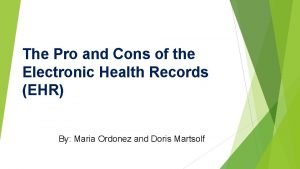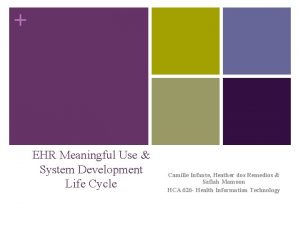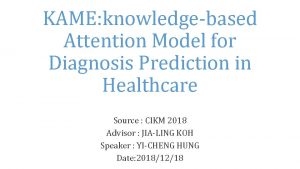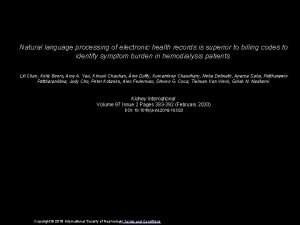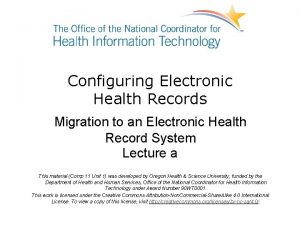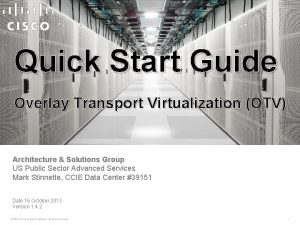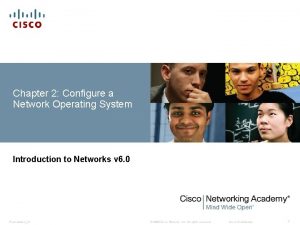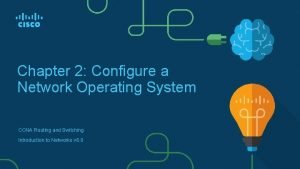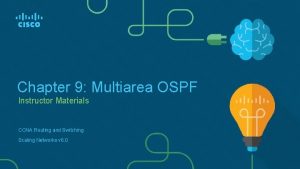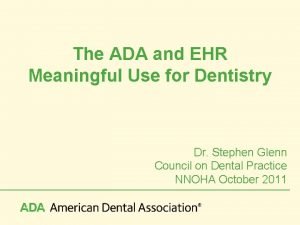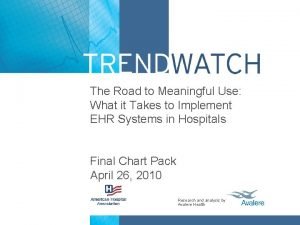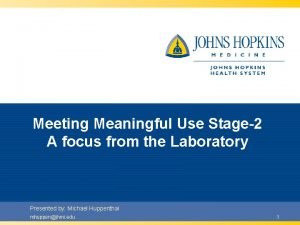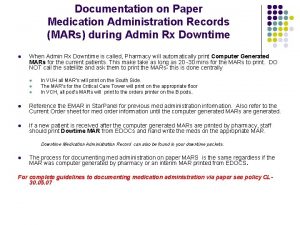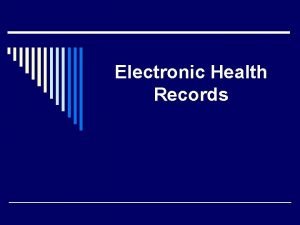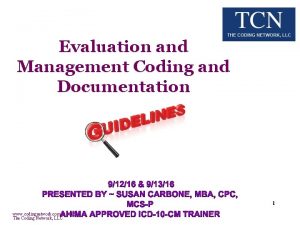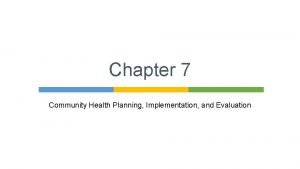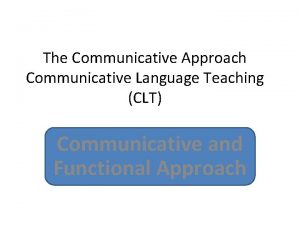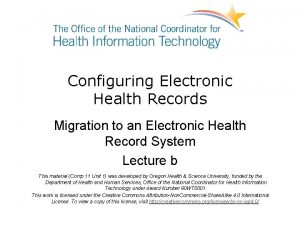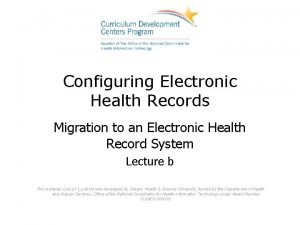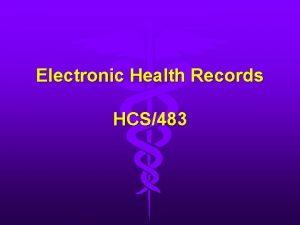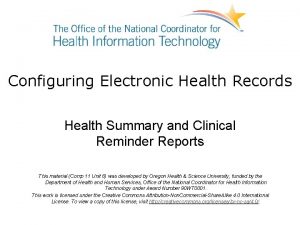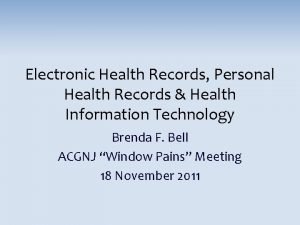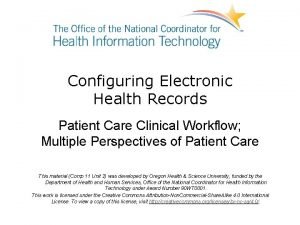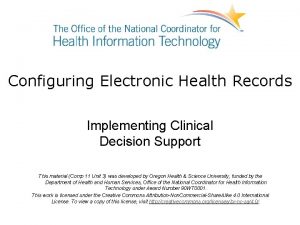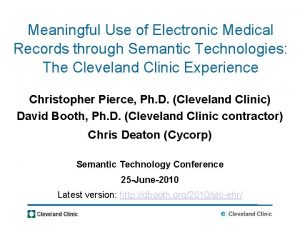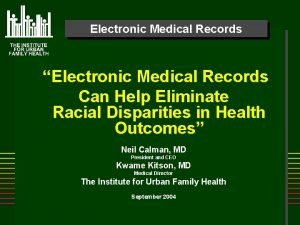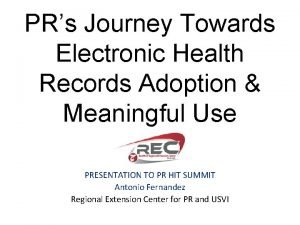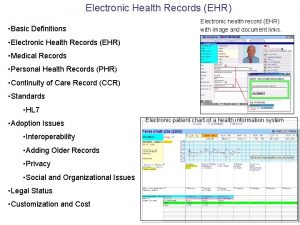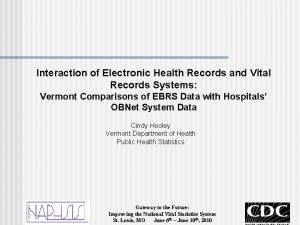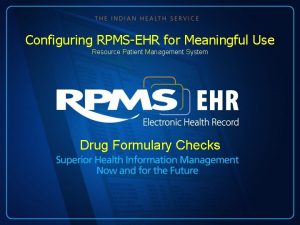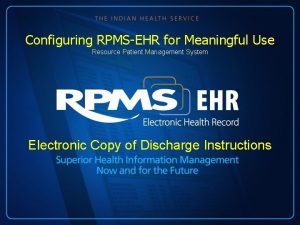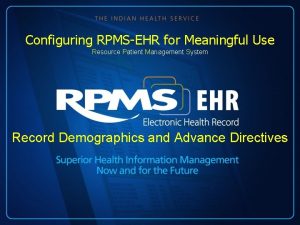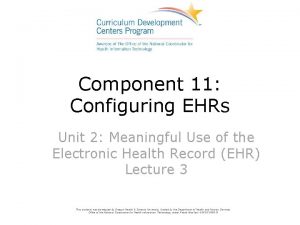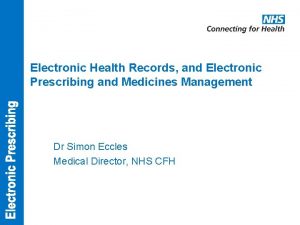Configuring Electronic Health Records Meaningful Use and Implementation






















- Slides: 22

Configuring Electronic Health Records Meaningful Use and Implementation Lecture a This material (Comp 11_Unit 8 a) was developed by Oregon Health & Science University, funded by the Department of Health and Human Services, Office of the National Coordinator for Health Information Technology under Award Number IU 24 OC 000015.

Meaningful Use and Implementation Learning Objectives • Describe meaningful use (MU) of health information technology in the context of the Health Information Technology for Economic and Clinical Health (HITECH) Act (Lecture a) • Define the criteria for Stage 1 of meaningful use for eligible professionals and eligible hospitals (Lecture a) • Demonstrate examples of meaningful use using the Vist. A Electronic Health Record (EHR) (Lecture b) Health IT Workforce Curriculum Version 3. 0/Spring 2012 Configuring Electronic Health Records Meaningful Use and Implementation Lecture a 2

Meaningful Use and HITECH • Health Information Technology for Economic and Clinical Health (HITECH) Act of the American Recovery and Reinvestment Act (ARRA) – Incentives for electronic health record (EHR) adoption by physicians and hospitals (up to $27 B) – Direct grants administered by federal agencies ($2 B) • HITECH provides financial incentives for “meaningful use” (MU) of HIT (Blumenthal, 2010; Trotter, 2011) Health IT Workforce Curriculum Version 3. 0/Spring 2012 Configuring Electronic Health Records Meaningful Use and Implementation Lecture a 3

MU is Driven by Underlying Goals for Healthcare System • All MU criteria must “map” to one of more of five goals for the healthcare system – Improving quality, safety, and efficiency – Engaging patients in their care – Increasing coordination of care – Improving the health status of the population – Ensuring privacy and security • Examples – Implement drug-drug interaction checks → Improving quality, safety, and efficiency – Provide summary of care to patients → Engaging patients in their care Health IT Workforce Curriculum Version 3. 0/Spring 2012 Configuring Electronic Health Records Meaningful Use and Implementation Lecture a 4

Overall Requirements for MU • Use certified EHR technology in a meaningful manner • Use certified EHR technology connected in a manner that provides for health information exchange to improve the quality of care • Using certified EHR technology, the provider submits information on clinical quality measures Health IT Workforce Curriculum Version 3. 0/Spring 2012 Configuring Electronic Health Records Meaningful Use and Implementation Lecture a 5

Certified EHR • A qualified EHR certified by an approved certifying entity • A qualified EHR is an electronic record of health-related information on an individual that – Includes patient demographic and clinical health information, such as medical history and problem lists – Has the capacity to • • Provide clinical decision support Support physician/provider order entry Capture and query information relevant to healthcare quality Exchange electronic health information with, and integrate such information from, other sources Health IT Workforce Curriculum Version 3. 0/Spring 2012 Configuring Electronic Health Records Meaningful Use and Implementation Lecture a 6

MU Implemented in Three Stages 2. 1 Figure: Stage 1 rules set in 2010 (Blumenthal, 2010); Stage 2 rules likely to be announced in 2012 (Drazen, 2011). (Missouri Health Information Technology Assistance Center, nd. ) Health IT Workforce Curriculum Version 3. 0/Spring 2012 Configuring Electronic Health Records Meaningful Use and Implementation Lecture a 7

Implementation • Implemented through increased Medicare or Medicaid reimbursement to – Eligible professionals (EPs) • Medicare: MD, DO, DDS/DMD, DPM, OD, DC • Medicaid: MD, DO, DDS/DMD, Certified Nurse Midwives, Nurse Practitioners, Physicians Assistants operating at an FQHC/RHC • Hospital-based EPs not eligible (>90% service in hospital, e. g. , pathologist, emergency physician) – Eligible hospitals (EHs) • Medicare: Acute Care Hospitals, Critical Access Hospitals (CAHs) • Medicaid: Acute Care Hospitals, CAHs, Children’s Hospitals • Within the 50 states and DC • Various differences in Medicare vs. Medicaid for amount reimbursed, rules, and other aspects Health IT Workforce Curriculum Version 3. 0/Spring 2012 Configuring Electronic Health Records Meaningful Use and Implementation Lecture a 8

Payment for Eligible Professionals (Eps) • Medicare – Up to $44, 000 over five years if start in 2011 or 2012; less if start later – Up to extra $4, 400 if practice in Health Professional Shortage Area • Medicaid – Up to $63, 750 over six years, with one-third in first year – Can receive money for first year just for implementing or upgrading to a certified EHR Health IT Workforce Curriculum Version 3. 0/Spring 2012 Configuring Electronic Health Records Meaningful Use and Implementation Lecture a 9

Payment for Eligible Hospitals (EHs) • More complex depending on Medicare vs. Medicaid, hospital type, and share of patients • Multi-campus hospitals count as one EH • General formula is that payment is multiplication of – Initial amount – $2 M + $200 per discharge for 1, 150 th to 23, 000 th discharge (maximum for 21, 850 discharges is $2 M + $4. 37 M = $6. 37 M) – Medicare or Medicaid share – Transition factor – 1. 0, 0. 75, 0. 5, and 0. 25 over four years depending on when become eligible Health IT Workforce Curriculum Version 3. 0/Spring 2012 Configuring Electronic Health Records Meaningful Use and Implementation Lecture a 10

Rules • Stage 1 final rules published on July 28, 2010 – CMS – Medicare and Medicaid Programs; Electronic Health Record Incentive Program; Final Rule – ONC – Health Information Technology: Initial Set of Standards, Implementation Specifications, and Certification Criteria for Electronic Health Record Technology – For those without time to read hundreds of pages, there are excellent summaries and other materials from HHS, HIMSS, CSC, and Geek Doctor blog • CMS Web site for program – http: //www. cms. gov/ehrincentiveprograms/ • EHR certification process guided by Temporary Certification Rule released on June 24, 2010, to be superseded by Permanent Certification Rule released in January, 2011 to start in 2012 – http: //healthit. hhs. gov/certification/ Health IT Workforce Curriculum Version 3. 0/Spring 2012 Configuring Electronic Health Records Meaningful Use and Implementation Lecture a 11

Criteria for Stage 1 MU • Final rules specified – Core objectives – all must be met – Menu objectives – selected from set • EPs must report on 15 core and 5 of 10 menu objectives • EHs must report on 14 core and 5 of 10 menu objectives • For EPs and EHs, one menu objective must be a public health measure (Blumenthal, 2010; CSC, 2010) Health IT Workforce Curriculum Version 3. 0/Spring 2012 Configuring Electronic Health Records Meaningful Use and Implementation Lecture a 12

Stage 1 Core Objectives • >50% of all unique patients have demographics recorded: preferred language, gender, race, ethnicity, date of birth • >50% of all unique patients age 2+ have recorded height, weight, blood pressure, calculated BMI, growth charts age 2 -20 • >80% of all unique patients have at least 1 entry or indication of none on problem list • >80% of all unique patients have at least 1 entry or indication of none on med list Health IT Workforce Curriculum Version 3. 0/Spring 2012 Configuring Electronic Health Records Meaningful Use and Implementation Lecture a 13

Stage 1 Core Objectives (continued) • >80% of all unique patients have at least 1 entry or indication of none on med allergy list • >50% of patients age 13+ seen have smoking status recorded • Provide clinical summaries to patient for more than 50% of all office visits within 3 business days Health IT Workforce Curriculum Version 3. 0/Spring 2012 Configuring Electronic Health Records Meaningful Use and Implementation Lecture a 14

Stage 1 Core Objectives (continued) • >50% provide patients with an electronic copy of health info upon request within 3 business days • >40% of all permissible prescriptions transmitted electronically (e. Rx) • >30% of unique patients have at least 1 med order entered using CPOE Health IT Workforce Curriculum Version 3. 0/Spring 2012 Configuring Electronic Health Records Meaningful Use and Implementation Lecture a 15

Stage 1 Core Objectives (continued) • Drug-drug and drug-allergy interaction checks enabled • Perform at least 1 test of certified EHR technology's capacity to electronically exchange key clinical information • Implement 1 clinical decision support rule relevant to specialty or high clinical priority with ability to track compliance • Conduct or review a security risk analysis and implement security updates as necessary • Report quality measures to CMS or states – provide aggregate numerator, denominator, and exclusions Health IT Workforce Curriculum Version 3. 0/Spring 2012 Configuring Electronic Health Records Meaningful Use and Implementation Lecture a 16

Stage 1 Menu Objectives • Implement drug-formulary checks • >40% results incorporate clinical lab-test results in certified EHR technology as structured data • Generate lists of patients by specific conditions to use for QI, reduction of disparities, research or outreach • >10% use certified EHR technology to identify patient-specific education resources and provide those resources to the patient if appropriate Health IT Workforce Curriculum Version 3. 0/Spring 2012 Configuring Electronic Health Records Meaningful Use and Implementation Lecture a 17

Stage 1 Menu Objectives (continued) • Perform medication reconciliation for >50% of transitions of care • Summary of care record is provided for >50% of patient transitions or referrals • Capability to submit electronic data to immunization registries or immunization information systems • Capability to submit electronic syndromic surveillance data to public health agencies Health IT Workforce Curriculum Version 3. 0/Spring 2012 Configuring Electronic Health Records Meaningful Use and Implementation Lecture a 18

Stage 1 Menu Objectives for Hospitals Only • >50% of patients age 65+ have an indication of an advance directive status recorded • Perform at least one test of data submission and follow-up submission (where public health agencies can accept electronic data) Health IT Workforce Curriculum Version 3. 0/Spring 2012 Configuring Electronic Health Records Meaningful Use and Implementation Lecture a 19

Stage 1 Menu Objectives for Professionals Only • >20% of patients of age 65+ or <5 are sent appropriate reminders for preventive and followup care • Provide patients with timely electronic access to their health information – >10% within 4 business days Health IT Workforce Curriculum Version 3. 0/Spring 2012 Configuring Electronic Health Records Meaningful Use and Implementation Lecture a 20

Meaningful Use and Implementation Summary – Lecture a • The HITECH Act of ARRA legislated incentives for the “meaningful use” (MU) of health IT • MU means that criteria for use of IT are tied back to goals of the healthcare system • These criteria are met by eligible professionals and eligible hospitals to receive incentive payments for use of EHRs Health IT Workforce Curriculum Version 3. 0/Spring 2012 Configuring Electronic Health Records Meaningful Use and Implementation Lecture a 21

Meaningful Use and Implementation References – Lecture a References • Anonymous. (2010). Medicare and Medicaid Programs; Electronic Health Record Incentive Program; Final Rule. Washington, DC: Federal Register Retrieved from http: //edocket. access. gpo. gov/2010/pdf/2010 -17207. pdf. • Anonymous. (2010). Health Information Technology: Initial Set of Standards, Implementation Specifications, and Certification Criteria for Electronic Health Record Technology; Final Rule. (E 9 -31216). Washington, DC: Federal Register Retrieved from http: //edocket. access. gpo. gov/2010/pdf/2010 -17210. pdf. • Blumenthal, D. (2010). Launching HITECH. New England Journal of Medicine, 362, 382 -385. • Blumenthal, D. , & Tavenner, M. (2010). The “meaningful use” regulation for electronic health records. New England Journal of Medicine, 363, 501 -504. • Drazen, E. (2011). Update on Stage 2: Current Direction and Timing of Meaningful Use Requirements. Waltham, MA: Computer Sciences Corp. Retrieved from http: //www. csc. com/health_services/insights/67921 update_on_stage_2_current_direction_and_timing_of_meaningful_use_requirements • Trotter, F. , & Uhlman, D. (2011). Getting to Meaningful Use and Beyond. Sebastopol, CA: O'Reilly Media. Charts, Tables, Figures • 2. 1 Figure: Overview: What is Meaningful Use? , Missouri Health Information Technology Assistance Center. Stage 1 rules set in 2010 (Blumenthal, 2010); Stage 2 rules likely to be announced in 2012 (Drazen, 2011). Retrieved from http: //assistancecenter. missouri. edu/node/17. Accessed Jan 2012. Health IT Workforce Curriculum Version 3. 0/Spring 2012 Configuring Electronic Health Records Meaningful Use and Implementation Lecture a 22
 Pros and cons of electronic health records
Pros and cons of electronic health records System development life cycle of electronic health records
System development life cycle of electronic health records Electronic health records
Electronic health records Language
Language +electronic +health +records +migration
+electronic +health +records +migration Human becoming theory
Human becoming theory Configuring otv
Configuring otv Outline proxy
Outline proxy Configure a network operating system
Configure a network operating system Configuring a network operating system
Configuring a network operating system Packet tracer configuring multiarea ospfv2
Packet tracer configuring multiarea ospfv2 Meaningful use dental
Meaningful use dental Meaningful use penalties chart
Meaningful use penalties chart Loinc meaningful use
Loinc meaningful use Electronic field production examples
Electronic field production examples Paper medication administration record
Paper medication administration record Paper vs electronic medical records
Paper vs electronic medical records Uncitral model law on electronic signatures
Uncitral model law on electronic signatures Benefits of public health
Benefits of public health Electronic medical records
Electronic medical records Scrip exchange
Scrip exchange Community health planning and implementation
Community health planning and implementation Picture strip story in communicative language teaching
Picture strip story in communicative language teaching
